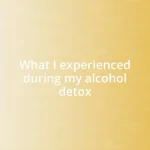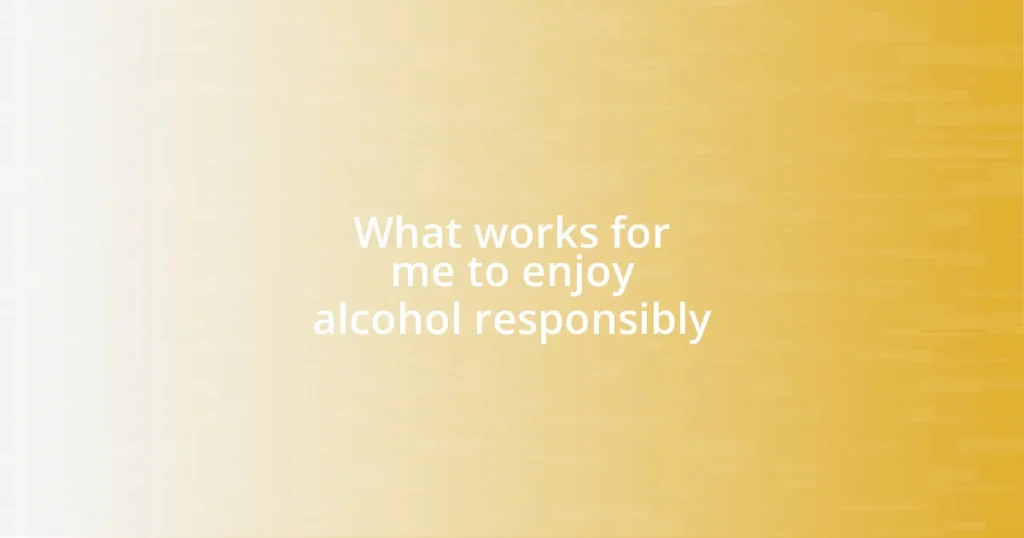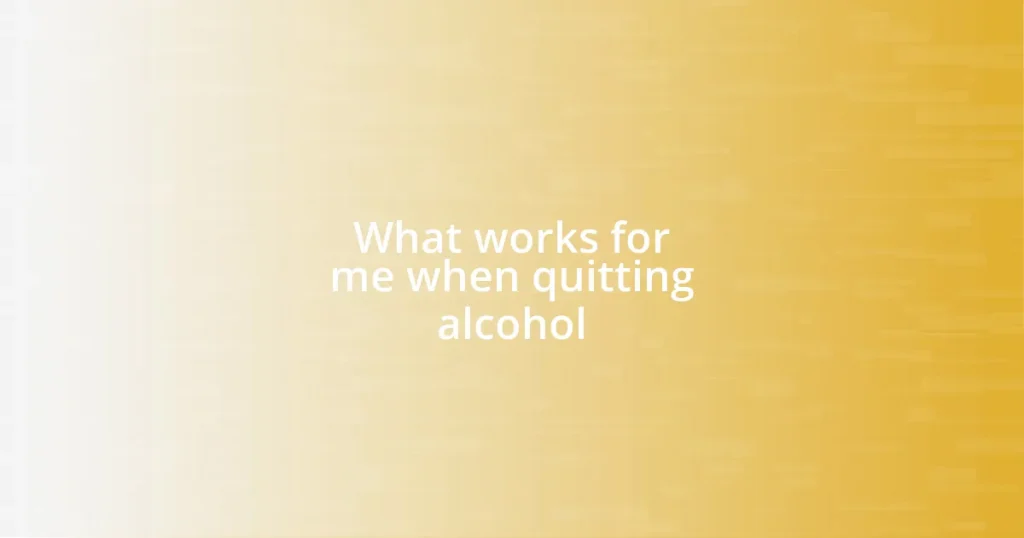Key takeaways:
- Alcohol availability policies significantly influence community health, drinking behaviors, and rates of alcohol-related incidents.
- Countries with stricter regulations often report lower alcohol misuse and violence, highlighting the need for balanced policies that prioritize public health.
- Community engagement in policy development fosters ownership and accountability, leading to more effective alcohol regulation and education initiatives.
- Leveraging technology and educational campaigns can enhance alcohol policy effectiveness, promoting responsible consumption and informed community actions.
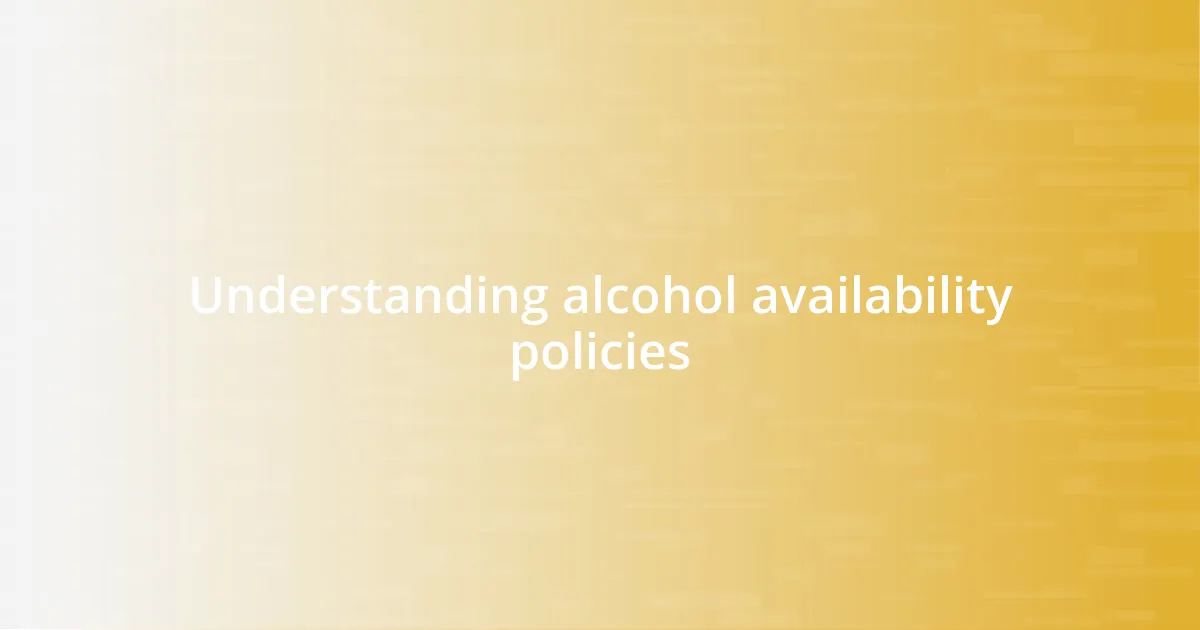
Understanding alcohol availability policies
Alcohol availability policies play a crucial role in shaping our communities and influencing public health outcomes. I remember attending a local town hall where residents passionately debated the hours during which liquor stores could operate. It struck me how access to alcohol affects not just individuals, but entire neighborhoods — can you imagine the impact if a local store sells alcohol 24/7?
Policies surrounding alcohol availability can vary significantly from one region to another, reflecting cultural attitudes and public health priorities. In my experience, when stricter regulations are put in place, like reducing the hours of sale, I’ve seen positive changes in the community’s drinking behavior. It begs the question: how much easier would it be for young people to make responsible choices if access were limited?
Moreover, these policies are often influenced by advocacy groups aiming for safer environments. I recall volunteering with a health initiative that highlighted the link between alcohol availability and incidents of violence. It really made me think; if we don’t consider the broader implications of these policies, how can we truly foster healthier communities? Balancing accessibility with safety is an intricate dance that requires thoughtful consideration.

Effects on public health
Alcohol availability policies have a profound impact on public health, particularly regarding rates of alcohol abuse and related injuries. I once witnessed a close friend struggle with alcohol dependency; it was heartbreaking to see how easily accessible liquor was in our neighborhood. Stricter policies could mean fewer binge-drinking incidents, ultimately leading to healthier communities.
When I worked on a public health campaign, we highlighted the correlation between high alcohol availability and road traffic accidents. It struck me how minor adjustments—like limiting retail hours—could lead to significant reductions in drunk driving incidents. If those changes save even one life, isn’t it worth the discussion?
Interestingly, neighborhoods with reduced access to alcohol often report lower instances of violence and crime. This isn’t just statistics; it’s about creating safe spaces where families can thrive. I can still hear the voices of parents in our community thanking us for advocating safer availability practices. Their relief was palpable, reminding me how essential these policies are to fostering emotional and physical well-being.
| Policy Type | Public Health Effects |
|---|---|
| Strict Regulations | Lower alcohol abuse rates |
| Limited Sale Hours | Decrease in drunk driving incidents |

Economic implications of alcohol access
Access to alcohol carries significant economic implications that can ripple throughout our communities. I’ve seen firsthand how increasing the availability of alcohol can lead to higher sales tax revenues, yet those benefits often come with hidden costs. For example, local governments might find themselves footing the bill for increased healthcare expenses related to alcohol-related illnesses and accidents, creating a cycle that’s hard to break.
- Increased alcohol sales can boost local economy through higher tax revenues.
- However, the costs of healthcare and law enforcement related to alcohol misuse might outweigh these benefits.
- Communities may experience economic instability due to lost work hours from alcohol-related problems.
- Areas with high alcohol availability can struggle to attract businesses that prioritize family-friendly environments.
I remember attending a community meeting focused on revitalizing our town. We discussed how the local bar scene attracted young people but also brought in gangs and violence. This pushed away potential investors and families. It left me wondering, are we trading economic growth for stability? Striking a balance between access and community welfare is essential for sustainable economic health.

Comparative analysis of global policies
Examining global policies on alcohol availability reveals stark contrasts in approaches and outcomes. For instance, in places like Sweden, where strict regulations dominate, I’ve found that alcohol sales are limited to government-controlled outlets, resulting in surprisingly lower rates of alcohol misuse. These policies create a controlled environment that might feel restrictive but, from my perspective, prioritizes public health over profit.
On the other hand, I’ve observed more liberal approaches in countries like the United States, where alcohol is widely available and often marketed aggressively. This unrestricted access can lead to a culture of excessive consumption. I often wonder how many people realize that the casual, everyday drinking they engage in could be contributing to broader societal issues, like increased healthcare costs and family disruptions.
Moreover, countries with middle-ground policies, such as New Zealand, utilize a mix of regulations and public education campaigns. I recall hearing about a community initiative there that encouraged responsible drinking during festivals, which resonated with local values. It’s fascinating to see how tailored policies can reflect cultural attitudes and lead to improved outcomes, emphasizing that one size does not fit all when it comes to managing alcohol availability.

Best practices for effective regulation
Effective regulation of alcohol availability often hinges on a balanced approach that considers both access and health. During a recent discussion with health officials, I was struck by how comprehensive policies—including minimum pricing and restricted hours—can lead to remarkable public health improvements. I mean, doesn’t it make sense to create barriers that encourage responsible consumption rather than promoting unrestricted access?
Community involvement is crucial in shaping these regulations. In my own town, we established a task force that included local residents, business owners, and healthcare professionals to voice their concerns and suggestions about alcohol sales. The collaboration fostered trust and resulted in more effective policies, like establishing a buffer zone around schools and parks. Have you ever wondered how empowering local voices can pave the way for meaningful change?
Lastly, continuous evaluation of these regulations is key. I’ve often seen communities reassess their policies after conducting thorough studies on consumption patterns and public health outcomes. This adaptive approach not only addresses emerging challenges but also ensures that regulations keep pace with the evolving social landscape. Isn’t it empowering to think that with the right strategies and a willingness to adapt, we can cultivate a safer environment for everyone?
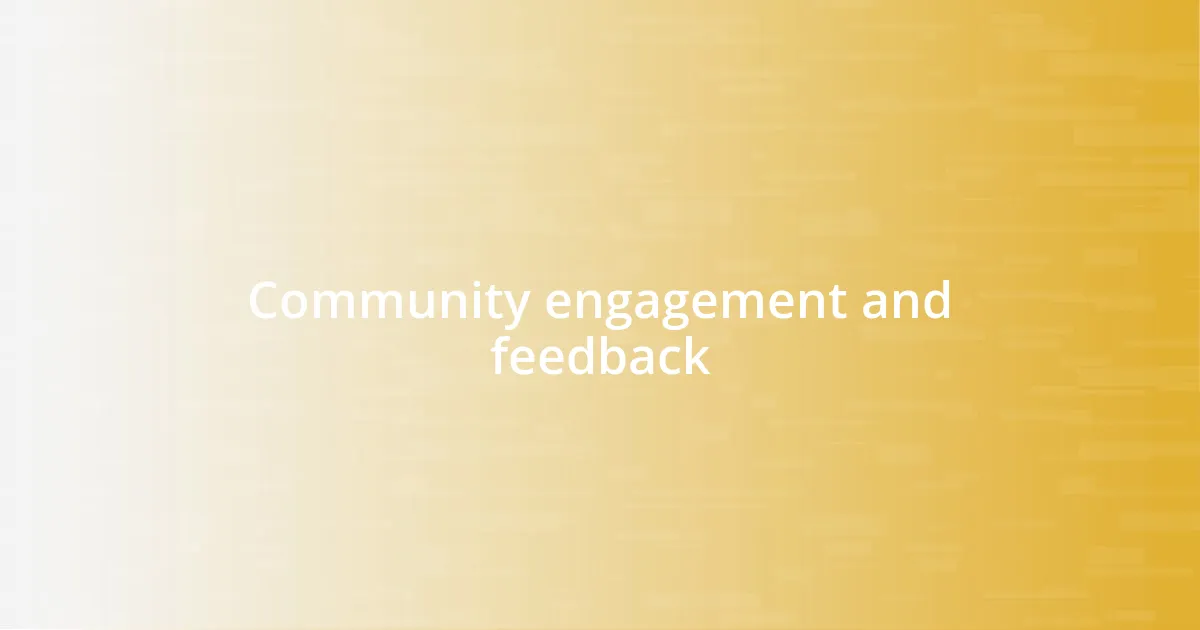
Community engagement and feedback
Community engagement is key to developing effective alcohol availability policies. I remember attending a town hall meeting where passionate residents presented their views on local alcohol regulations. The energy in the room was palpable, as people shared personal stories about how easily accessible alcohol had affected their families and friends. This kind of feedback is invaluable; it humanizes the statistics and helps policymakers understand the real-world impact of their decisions.
Listening to community voices doesn’t just inform policy; it cultivates a sense of ownership and responsibility. For instance, when my neighborhood formed a coalition to tackle alcohol-related issues, we included diverse voices—parents, teens, and local business owners—all sharing their perspectives. This dialogue helped us create an educational program for young adults about responsible drinking. It was amazing to see firsthand how people felt empowered when their opinions mattered, especially knowing that they were contributing to a solution.
Engaging the community doesn’t stop at feedback; it should also involve transparency in implementing policies. I recall a campaign where local officials shared the results of an alcohol consumption study with residents, really opening the floor for discussion. This not only built trust but also allowed community members to feel informed and engaged in the process. Have you noticed how communities thrive when they come together for a common cause? It’s clear that fostering this engagement leads to better outcomes, making it essential for driving effective alcohol policies.

Future directions for alcohol policy
As I reflect on the future of alcohol policies, it’s clear that leveraging technology can play a transformative role. For example, I came across initiatives where apps help residents track local alcohol sales and monitor their impact on community health. Can you imagine how this data could empower local leaders to make informed decisions that are responsive to real-time needs?
Another promising direction involves integrating educational campaigns into policy frameworks. I remember a successful pilot program that involved local schools in promoting awareness about the effects of binge drinking. When I saw students not only participating in the discussions but also presenting their own research on the topic, it really struck me how youth engagement fosters a sense of agency. Isn’t it fascinating to think that educating the next generation can lead to a cultural shift in how we perceive alcohol consumption?
Lastly, while stricter regulations are crucial, a balance with support services is essential for long-term success. For instance, I’ve seen places enhance their alcohol policies by also offering resources for addiction treatment and community support groups. This holistic approach made such a difference in my town, showing that addressing availability coupled with support can create a healthier community. Have you ever thought about how interconnected these policies truly are?




